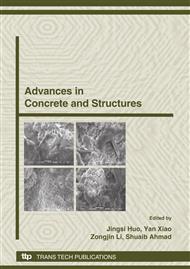p.341
p.347
p.355
p.363
p.371
p.379
p.385
p.391
p.395
Experiment and Analysis of Smart Concrete Beam Strengthened Using Shape Memory Alloy Wires
Abstract:
Shape memory alloy (SMA) has many potential applications as an actuator in smart material systems due to its abilities of shape memory, pseudo-elasticity, high damping and wear resistant. In this paper, a smart concrete beam has been developed by taking advantage of the shape memory effect of SMA and the characteristic of applying large forces on the resisting member in the transformation of SMA on heating. Deformation behavior and influence of factors on the deformation behavior of SAM smart concrete beam were investigated experimentally. Actuation mechanics of SMA was analyzed. Experimental results show that SMA wires significantly increase structural survivability and allow structural to recover from residual deformation by damaged earthquake and typhoon, and the crack almost closes completely after electrically heating the SMA wires. The number or areas of SMA wires has no influence on the tendency of deformation during loading and the tendency of reversion by heating. An increasing of the initial pre-strain of SMA wire can significantly improve the capacity of self-restoration of SMA concrete beams, but the steel main bars play a very negative role in reducing residual deformation.
Info:
Periodical:
Pages:
371-377
Citation:
Online since:
October 2008
Authors:
Price:
Сopyright:
© 2009 Trans Tech Publications Ltd. All Rights Reserved
Share:
Citation:


